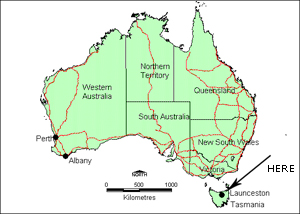Three River Theatre, The Season at Sarsparilla, by Patrick White
University of Tasmania senior lecturer, Dr Deb Malor, came along the student preview night and shared her reflections on the show.
With The Season at Sarsaparilla, Nobel Prize-winning Australian author, Patrick White, encounters his homeland after a lengthy period spent in Europe after service in World War 2, during which he wrote his first performed play, The Ham Funeral, set in a decrepit London boarding house. The Ham Funeral was the first public evidence of the establishment, grazier-class, Cambridge-educated White's taste for 'slumming it', through a voyeur's fascination for communities not his own.
Like The Ham Funeral, The Season at Sarsaparilla was first performed in Adelaide: indeed in the following year, 1962. The play has had a number of outings, most notably for me the 1976 Sydney production for the Old Tote Theatre Company, directed by Jim Sharman, in enfant terrible mode and bringing new power to the play's final impossible injunction to spread the 'razzle dazzle' to Mildred Street, Sarsaparilla. In a way, you had to be living in Sydney to admire White's rather cynical demand to break the bubble of suburbia, subjected as we had been to the onslaught of David Williamson's gentrifying inner city 'trendies' in plays such as Don's Party;although, as the director, Leigh Oswin, writes in his excellent notes, there is much in this play that is recognisable in the world of 2017.
For Oswin, with his interest in meta-theatre, this play must have seemed a gift, with its layered and often self-conscious actions, moments when characters form of chorus in mime and word and the occasional interpolations of a single character, Roy Child (Rhys Pitstock) who dreams and rants beyond the picket fence. Throughout it is the effective and consistent use of mime that underline the monotony of life through repeated actions that allow us to tune in to White's intersecting dialogues.
The play is an ensemble piece, concentrating on the residents of three adjacent houses: the Knotts, the Pogsons and the Boyles. Into these families are inserted, with varied intent and much élan: an amoral politician, Mr Erbage, played by a suitably sweaty Antony Butchart; an old war-time mate in Aaron Beck's damaged and dangerous Rowley Masson; a romantic and gauche suitor, Ron Suddards, breathlessly realised by Robbie Bleakley; a vivacious yet fragile woman - Fran Suitor as Julia Sheen; and a pair of ambulance men - the big boys of the Launceston stage, Cameron Hindrum and Callum Westwood).
Among sustained scenes of deep intensity and superficial manners, there are many comedic moments. Some have not aged well: what may have encouraged pub laughter in the 1960s brought some gasps of shock/horror from a much younger audience with a lifetime protection from non-pc language and ideas. Happily Jan Gluszyk (as Clive Pogson) and Aaron Beck navigate the area seamlessly, both avoiding caricature and remaining totally engaging if not always likeable. Relationships between couples are beautifully drawn, without exception: Clive and Girlie Pogson (Gluszyk and Fiona Reilly); Harry and Mavis Knott (Kieran Phillips and Katie Hill); Ernie and Nola Boyle (Troy Ridgway and Bindy Stephens) all have some hook that keeps them together, even if that is the suppressing of irritations, the forgetting of fragilities, the acceptance of 'What more could anyone expect?', as Girlie and Clive agree. The Pogson children, Judy (Jane Forrest) and Pippy (Charlotte Edwards) provide markers of life stages where decisions must be made and new facades adopted, demonstrated by Judy's acceptance of the 'kindness', derided by Roy Child, that she recognises in youthful romantic Ron Suddards; and Pippy's changing attitudes to her neighbours and to her friend, Deedree, played straight while channelling a junior Magda Szubanski by Delia Muddle. Roy (resident in the Knott household) is the one person who attempts to exist on both sides of the facade, inside and outside the charade of suburbia but in the end it just may be possible that the courageous and curious Pippy will be the one to not acquiesce to the expectations of a gender-defined adulthood.
Design has been the province of Leigh Oswin, Stan Gottschalk, Flocky Bock and Nick Cummings and is almost without fault. The set plays to the idea of charade in its open 'facadery', the delineation of spaces by varied levels and surfaces that are, in turn, supported by mimed actions of the opening and closing of doors and gates. Entering the theatre is to be drawn immediately into its bright simplicity space. The design is integral to the narrative. Under the frames of identical hipped roofs, a welter of Laminex, some incipient Marimekko, back porches with dark spaces underneath, narrow side walkways not used by strangers, eat-in kitchens with sinks under the window, the back lane as a merging or connecting space. It is a very full set, taking the full depth of the available space. This slightly detracts from the ability of Roy to clearly 'step outside' to declaim against the insularity of each ticky-tacky house, but that is slight criticism. Costume design is slick, from Dior copy ( a great entrance from Fran Suitor) to beige via pastels and polished cottons (although I was longing for an I Love Lucy house coat or two).
White's text can be difficult, not the least because knowledge of the irascible character of the author can get in the way. But White is no Woody Allen: his text must be both serious and ridiculous, preferably simultaneously, and he is not into public psychoanalysis. This is just how it is, in Mildred Street, Sarsaparilla. There can be no suggestion that White understands the motivations of the people he has placed on the stage before us: like us, he watches from his kitchen window, listens at the backdoor, bound by rules.
Three River Theatre's production of The Season at Sarsaparilla is a brave undertaking with an extremely satisfying outcome. It is very good entertainment indeed. Somewhere in Mildred Street you will find someone to love or to despise, to weep for or to laugh with. If you're not happy in one house, move on to the next; there will always be something reassuring, quiet, intense, well-behaved, contained within its bubble. Perhaps go along more than once, just to make sure you catch everything that's going on behind the facades of Sarsaparilla.
Contact
You can send a message to us at: stan@stanspage.com

